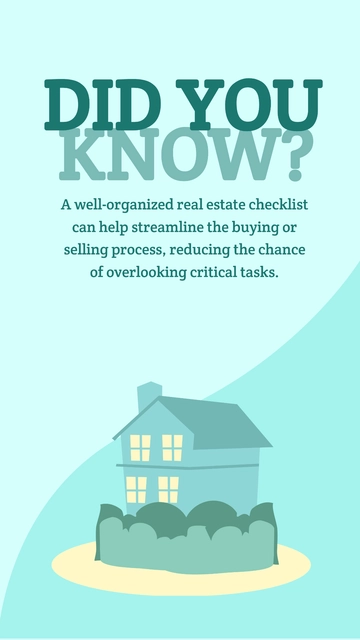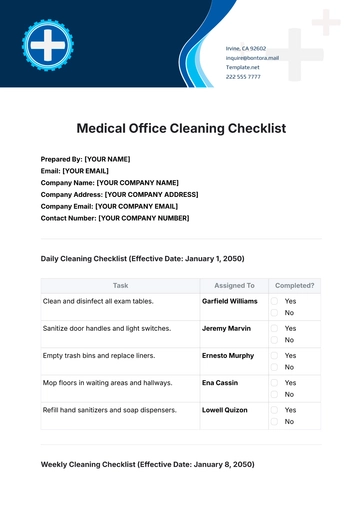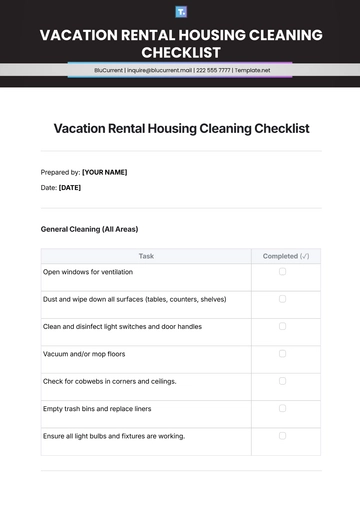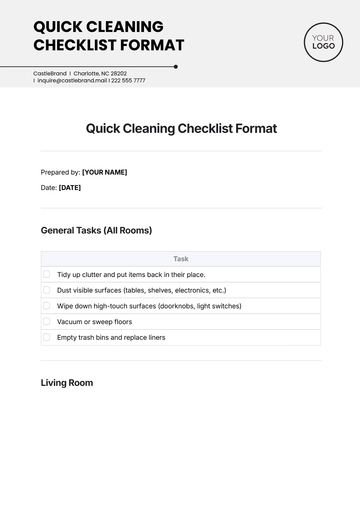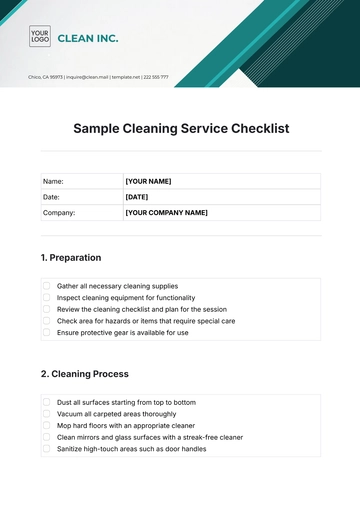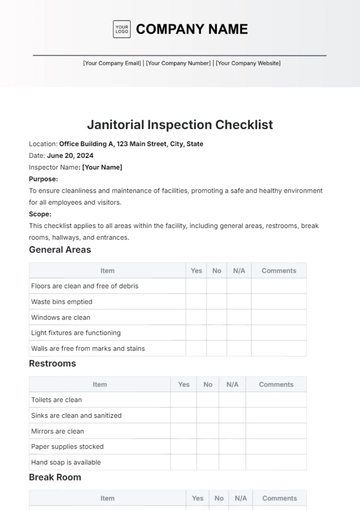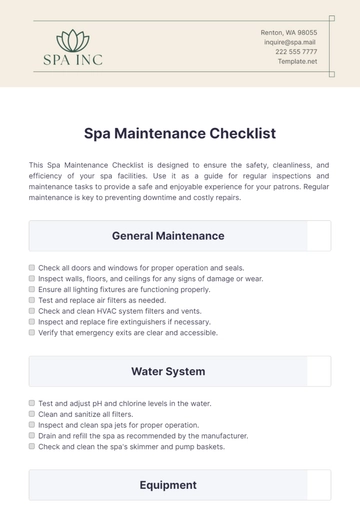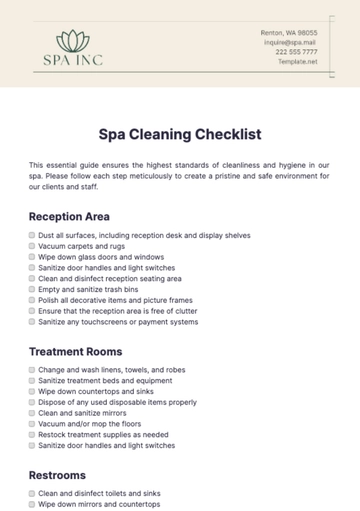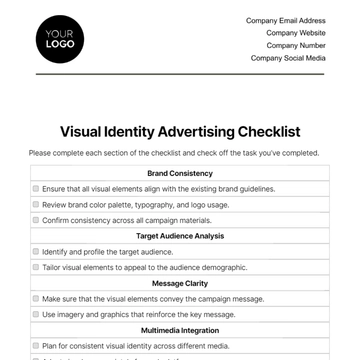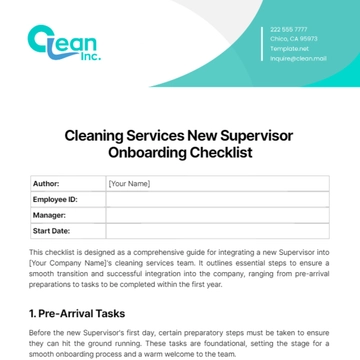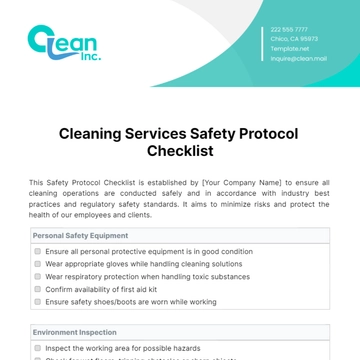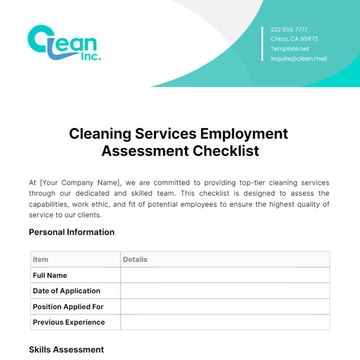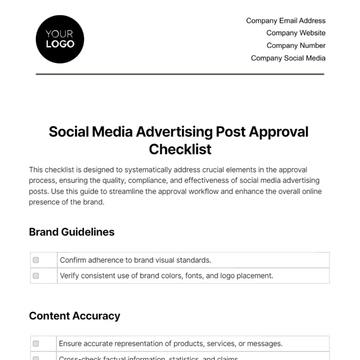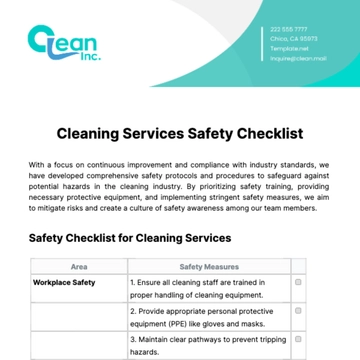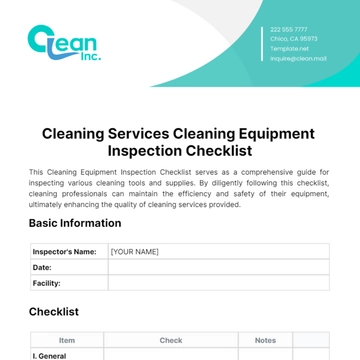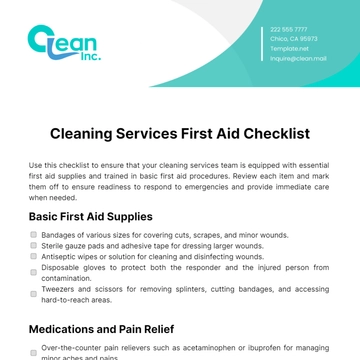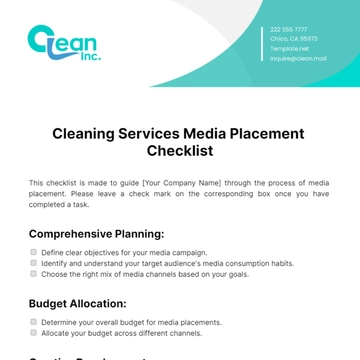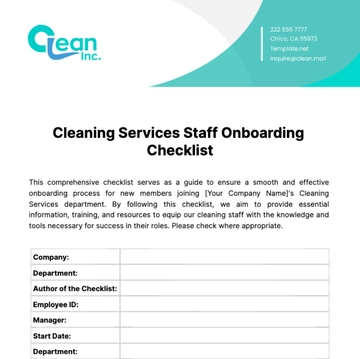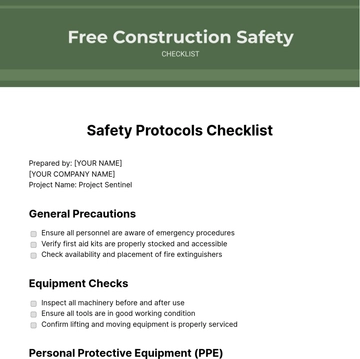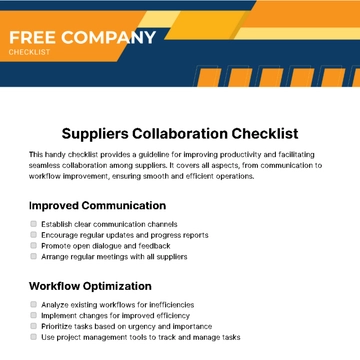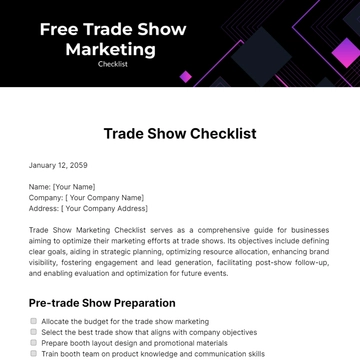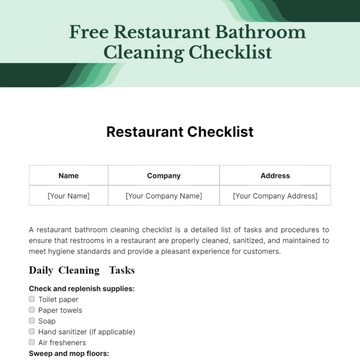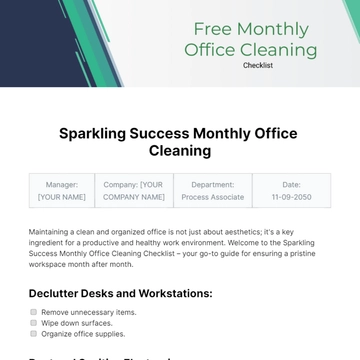Free Cleaning Services PPE Compliance Checklist
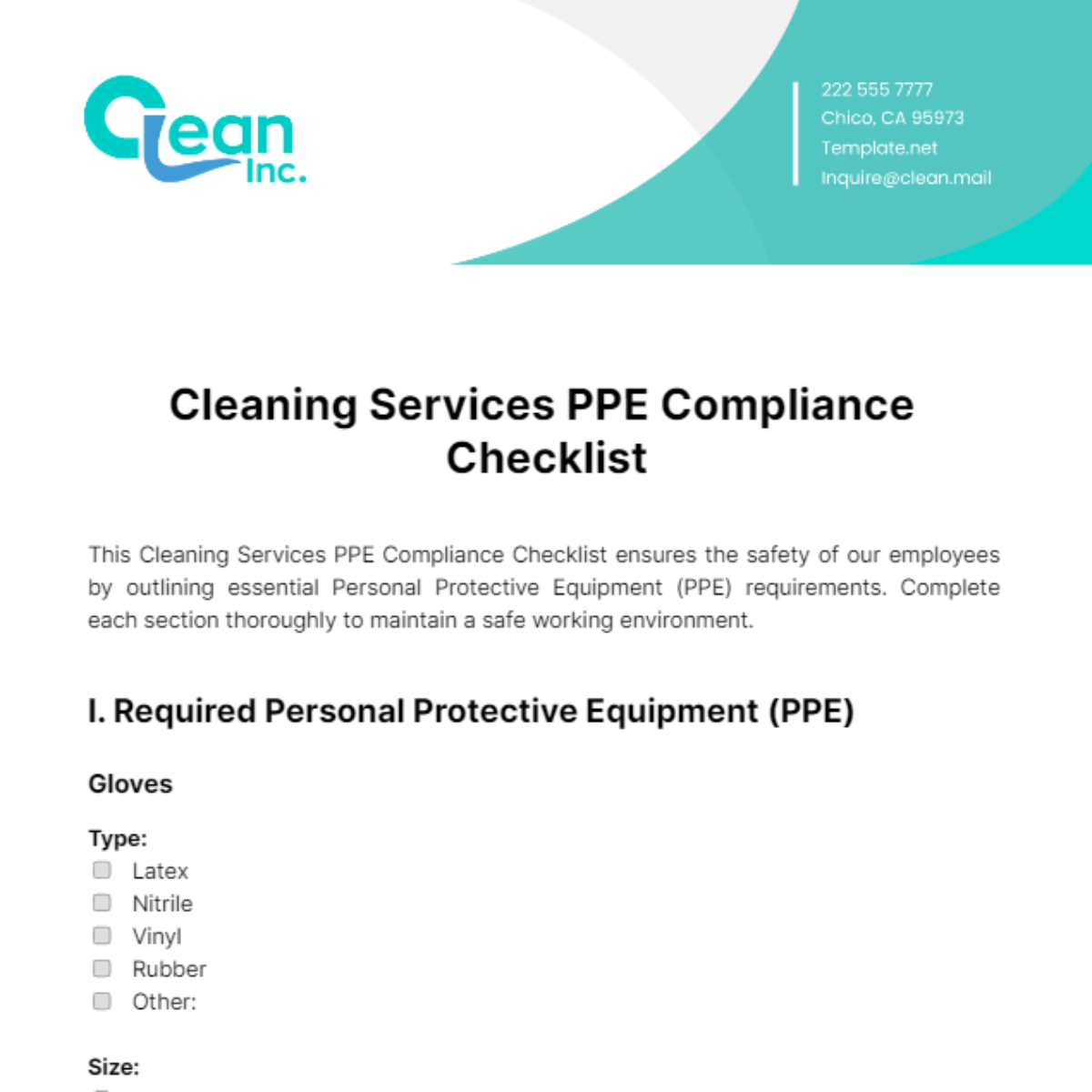
This Cleaning Services PPE Compliance Checklist ensures the safety of our employees by outlining essential Personal Protective Equipment (PPE) requirements. Complete each section thoroughly to maintain a safe working environment.
I. Required Personal Protective Equipment (PPE)
Gloves
Type:
Latex
Nitrile
Vinyl
Rubber
Other:
Size:
Small
Medium
Large
Extra Large
Eye Protection
Type:
Safety Glasses
Goggles
Face Shield
Other:
Face Masks/Respirators
Type:
N95 Respirator
Surgical Mask
Cloth Face Mask
Full-face Respirator
Powered Air-Purifying Respirator (PAPR)
Other:
Protective Clothing
Type:
Disposable Apron
Reusable Apron
Coveralls
Lab Coat
Chemical-resistant Suit
Other:
Footwear
Type:
Closed-toe Shoes
Steel-toe Boots
Slip-resistant Shoes
Waterproof Boots
Chemical-resistant Boots
Other:
Other PPE
Hearing Protection (if loud equipment is used)
Hard Hat (if there's a risk of falling objects)
Respirator Cartridges/Filters (if using respirators)
Training and Education
Conducted comprehensive training sessions on the proper selection, use, and maintenance of PPE for all cleaning staff.
Provided hands-on demonstrations to ensure employees understand how to properly don and doff PPE, emphasizing proper hygiene practices.
Implemented refresher training sessions on a quarterly basis to reinforce PPE protocols and address any questions or concerns from employees.
Incorporated interactive elements into training sessions, such as quizzes or scenario-based exercises, to promote active engagement and understanding.
Offered multilingual training materials and sessions to accommodate diverse staff members and ensure comprehension for all employees.
Fit Testing
Conducted fit testing for N95 respirators according to OSHA standards, ensuring proper fit and seal for each employee.
Scheduled individual fit testing appointments to minimize distractions and ensure accurate results for all staff members.
Provided education on the importance of fit testing and the proper wearing of respirators to enhance employee understanding and compliance.
Implemented a tracking system to monitor fit testing dates and ensure timely re-testing as required by regulations or changes in respirator type.
Collaborated with occupational health professionals to conduct fit testing sessions and ensure adherence to best practices and regulatory requirements.
Availability of PPE
Conducted regular inventory assessments to ensure adequate stock of all required PPE items and replenished supplies as needed.
Implemented a centralized PPE distribution system to streamline access and ensure equitable distribution among all cleaning staff.
Established a protocol for employees to request additional PPE or replacements promptly, minimizing downtime and potential safety risks.
Partnered with reliable suppliers to maintain a consistent supply chain and mitigate potential disruptions in PPE availability.
Utilized digital tracking systems to monitor PPE usage trends and anticipate future needs, enabling proactive procurement and resource allocation.
Inspection and Maintenance
Assigned designated personnel to conduct weekly inspections of all PPE items for damage, wear, or defects, documenting findings and initiating replacements as necessary.
Implemented a color-coded tagging system to indicate the status of each PPE item (e.g., green for good condition, red for damaged), facilitating quick visual assessments by staff members.
Conducted monthly maintenance checks on cleaning equipment, such as vacuum filters and respirator cartridges, to ensure optimal performance and effectiveness.
Established a process for employees to report any issues or concerns regarding PPE condition promptly, encouraging a culture of proactive safety communication.
Provided ongoing training to cleaning staff on proper PPE maintenance techniques, emphasizing the importance of regular inspections and care to prolong the lifespan of PPE items.
Compliance Monitoring
Implemented routine spot checks and observations to verify that employees are wearing required PPE correctly and consistently during cleaning tasks.
Conducted monthly safety audits focusing on PPE compliance, with feedback provided to employees and supervisors to address any areas of improvement.
Established a system for employees to anonymously report instances of non-compliance or safety concerns, fostering open communication and accountability.
Recognized and rewarded employees who consistently adhere to PPE protocols and demonstrate a commitment to safety in the workplace.
Developed a disciplinary process for addressing repeat violations of PPE requirements, with progressive consequences to reinforce the importance of compliance and accountability.
Documentation and Recordkeeping
Maintained comprehensive records of all PPE training sessions, including attendance logs and training materials distributed to employees.
Documented fit testing results for each employee, including the type of respirator tested, date of testing, and results of the fit test.
Recorded all PPE inspections and maintenance activities, noting any issues identified and actions taken to address them.
Established a centralized database for storing and organizing PPE-related documentation, ensuring easy access for regulatory audits or internal reviews.
Conducted regular reviews of PPE documentation to identify trends or areas for improvement, informing updates to training programs or PPE protocols as needed.
Review and Update
Scheduled quarterly meetings with safety committee members to review the effectiveness of current PPE protocols and identify opportunities for enhancements.
Conducted annual reviews of cleaning tasks and associated hazards to ensure that the PPE compliance checklist remains aligned with evolving needs and regulatory requirements.
Solicited feedback from cleaning staff on their experiences with PPE usage and suggestions for improvement, incorporating their input into updates of PPE protocols and training materials.
Stayed abreast of changes in industry standards and best practices related to PPE usage through participation in professional development opportunities and engagement with industry networks.
Collaborated with regulatory agencies and industry partners to exchange insights and best practices, leveraging external expertise to inform continuous improvement efforts related to PPE compliance.
- 100% Customizable, free editor
- Access 1 Million+ Templates, photo’s & graphics
- Download or share as a template
- Click and replace photos, graphics, text, backgrounds
- Resize, crop, AI write & more
- Access advanced editor
Streamline your cleaning service's safety protocols with the Cleaning Services PPE Compliance Checklist Template from Template.net. This editable and customizable template, crafted with our AI Editor Tool, ensures adherence to safety standards. Empower your team to prioritize safety with ease, allowing for efficient management and compliance in every cleaning task.
You may also like
- Cleaning Checklist
- Daily Checklist
- Travel Checklist
- Self Care Checklist
- Risk Assessment Checklist
- Onboarding Checklist
- Quality Checklist
- Compliance Checklist
- Audit Checklist
- Registry Checklist
- HR Checklist
- Restaurant Checklist
- Checklist Layout
- Creative Checklist
- Sales Checklist
- Construction Checklist
- Task Checklist
- Professional Checklist
- Hotel Checklist
- Employee Checklist
- Moving Checklist
- Marketing Checklist
- Accounting Checklist
- Camping Checklist
- Packing Checklist
- Real Estate Checklist
- Cleaning Checklist Service
- New Employee Checklist
- Food Checklist
- Home Inspection Checklist
- Advertising Checklist
- Event Checklist
- SEO Checklist
- Assessment Checklist
- Inspection Checklist
- Baby Registry Checklist
- Induction Checklist
- Employee Training Checklist
- Medical Checklist
- Safety Checklist
- Site Checklist
- Job Checklist
- Service Checklist
- Nanny Checklist
- Building Checklist
- Work Checklist
- Office Checklist
- Training Checklist
- Website Checklist
- IT and Software Checklist
- Performance Checklist
- Project Checklist
- Startup Checklist
- Education Checklist
- Home Checklist
- School Checklist
- Maintenance Checklist
- Planning Checklist
- Manager Checklist
- Wedding Checklist
- Vehicle Checklist
- Travel Agency Checklist
- Vehicle Inspection Checklist
- Interior Design Checklist
- Backpacking Checklist
- Business Checklist
- Legal Checklist
- Nursing Home Checklist
- Weekly Checklist
- Recruitment Checklist
- Salon Checklist
- Baby Checklist
- Equipment Checklist
- Trade Show Checklist
- Party Checklist
- Hospital Bag Checklist
- Evaluation Checklist
- Agency Checklist
- First Apartment Checklist
- Hiring Checklist
- Opening Checklist
- Small Business Checklist
- Rental Checklist
- College Dorm Checklist
- New Puppy Checklist
- University Checklist
- Building Maintenance Checklist
- Work From Home Checklist
- Student Checklist
- Application Checklist
